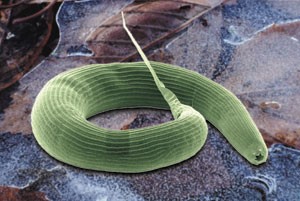Play all audios:
Access through your institution Buy or subscribe Nematodes are well suited to comparative morphological studies, as homologous cellular and developmental processes are easily detected in
closely related species. A classic example is the development of the nematode vulva — the mating and egg-laying structure — in _Caenorhabditis elegans_ and _Pristionchus pacificus_. The _C.
elegans_ vulva develops from 12 epidermal cells: six form the vulval equivalence group, and descendents of only three of them differentiate into the vulva proper. The Hox gene _lin-39_
(_lineage-39_) is required for two steps in vulval development: to establish the vulval equivalence group and, later, for vulval differentiation. Things are quite different in _P.
pacificus_: for example, the vulval equivalence group consists only of three cells; in addition, those cells that do not differentiate into the vulva die, unlike in _C. elegans_, in which
they fuse with the surrounding tissue. The function of _lin-39_ also differs in _P. pacificus_ — the gene is required to prevent cells from undergoing apoptosis, but is not required later
for vulval formation. What is the genetic basis for the different functions of LIN-39? A predicted MAPK docking and phosphorylation site at the carboxyl terminus of _C. elegans_ (_Cel_)
LIN-39, which is absent from the _P. pacificus_ (_Ppa_) LIN-39, at first seemed like a convincing candidate, but it was ruled out by functional studies. The lack of any other obvious
structural differences between the two LIN-39 proteins gave the first hint that they might be functionally equivalent — a possibility the authors confirmed by transgenic studies. Despite the
limited amino-acid similarity between the two proteins, a transgene that contains the _Ppa_–_lin-39_ cDNA was found to rescue the egg-laying and vulval cell lineage defects of a
_Cel–lin-39_ mutant but, crucially, only when driven by _Cel–lin-39_ control regions. The same transgene also restored the presence of the vulval cell neurons, which require _lin-39_. The
conclusion seems to be that the key to the difference between the two proteins lies in their respective control regions. This is a preview of subscription content, access via your
institution ACCESS OPTIONS Access through your institution Subscribe to this journal Receive 12 print issues and online access $209.00 per year only $17.42 per issue Learn more Buy this
article * Purchase on SpringerLink * Instant access to full article PDF Buy now Prices may be subject to local taxes which are calculated during checkout ADDITIONAL ACCESS OPTIONS: * Log in
* Learn about institutional subscriptions * Read our FAQs * Contact customer support REFERENCES ORIGINAL RESEARCH PAPER * Grandien, K. & Sommer, R. J. Functional comparison of the
nematode Hox gene _lin-39_ in _C. elegans_ and _P. pacificus_ reveals evolutionary conservation of protein function despite divergence of primary sequences. _Genes Dev._ 15, 2161–2172 (2001)
Article CAS Google Scholar FURTHER READING * Tautz, D. Evolution of transcriptional regulation. _Curr. Opin. Genet. Dev._ 10, 575–579 (2000) Article CAS Google Scholar Download
references Authors * Tanita Casci View author publications You can also search for this author inPubMed Google Scholar RIGHTS AND PERMISSIONS Reprints and permissions ABOUT THIS ARTICLE CITE
THIS ARTICLE Casci, T. Regulatory affairs. _Nat Rev Genet_ 2, 657 (2001). https://doi.org/10.1038/35088548 Download citation * Issue Date: 01 September 2001 * DOI:
https://doi.org/10.1038/35088548 SHARE THIS ARTICLE Anyone you share the following link with will be able to read this content: Get shareable link Sorry, a shareable link is not currently
available for this article. Copy to clipboard Provided by the Springer Nature SharedIt content-sharing initiative

